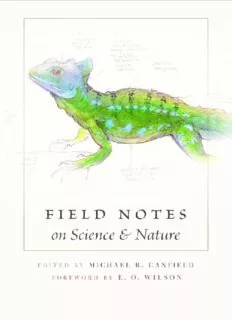
Field Notes on Science & Nature – NO IMAGES PDF
Preview Field Notes on Science & Nature – NO IMAGES
field note s on science & nature [To view this image, refer to the print version of this title.] f i e l d n o t e s on Science & Nature e d i t e d b y m i c h a e l r . c a n f i e l d f o r e w o r d b y e . o . w i l s o n harvard university press Cambridge, Massachusetts | London, England 2011 Copyright © 2011 by the President and Fellows of Harvard College all rights reserved Printed in Canada Chapter 5 was prepared by Anna K. Behrensmeyer as part of official duties as an employee of the Federal Government/Smithsonian Institution. The copyright in Field Notes on Science & Nature does not extend to this chapter. Many of the designations used by manufacturers and sellers to distinguish their products are claimed as trademarks. Where those designations appear in this book and Harvard University Press was aware of a trademark claim, then the designations have been printed in initial capital letters. Library of Congress Cataloging-in-Publication Data Field notes on science and nature / edited by Michael R. Canfield. p. cm. Includes bibliographical references and index. isbn 978-0-674-05757-9 (alk. paper) 1. Biology—Fieldwork. 2. Natural history—Fieldwork. 3. Note-taking. I. Canfield, Michael R. QH318.5.F54 2011 570.72—dc22 2011005780 frontispiece: A hand-drawn map of collecting localities in the Trans-Busu Timber Reserve near Lae, Morobe Province, Papua New Guinea, which was inserted in the back of a field notebook from E. O. Wilson’s collecting expedition to the South Pacific from 1954 to 1955. To Jen Foreword ix edward o. wilson Introduction 1 michael r. canfield 1 The Pleasure of Observing 19 george b. schaller 2 Untangling the Bank 33 bernd heinrich 3 One and a Half Cheers for List-Keeping 49 kenn kaufman 4 A Reflection of the Truth 67 roger kitching 5 Linking Researchers across Generations 89 anna k. behrensmeyer 6 The Spoken and the Unspoken 109 karen l. kramer c o n t e n t s 7 In the Eye of the Beholder 129 jonathan kingdon 8 Why Sketch? 161 jenny keller 9 The Evolution and Fate of Botanical Field Books 187 james l. reveal 10 Note-Taking for Pencilophobes 201 piotr naskrecki 11 Letters to the Future 211 john d. perrine and james l. patton 12 Why Keep a Field Notebook? 251 erick greene Notes 277 Acknowledgments 285 Contributors 289 Index 293 [To view this image, refer to the print version of this title.] Sketches and behavioral notes on Pyramica gundlachi, an ant species distributed throughout the Caribbean. August 16, 1953, Edward O. Wilson. f o r e wo r d . edward o wilson the second half of the twentieth century witnessed the rise of molecular and cellular biology, one of the greatest achievements in the history of science. The study of living things at the molecular level established what may be fairly called the First Law of Biology, that all the entities and processes of life are obedient to the laws of physics and chemistry. This research succeeded in part because it focused on several dozen species of “model organisms” to explore particular basic prob- lems, for example, the colon bacterium E. coli for molecular genetics, the roundworm C. elegans for the molecular underpinnings of nerve cell development, and honeybees for the molecular basis of advanced so- cial organization. Molecular biologists remained relatively unconcerned about the higher levels of biological organization, from organism to population, ecosystem, and society. They were also nonhistorical. As a consequence, relatively little attention was paid in the twentieth century to the Second Law of Biology, that all entities and processes of life were created by evolution through natural selection. Biologists in the present century are beginning to shift toward more of a balance in attention to these two great divisions. Even at the level of the molecule and cell, a trend toward synthesis—how the entities and processes fit together to make a cell, then an organism—is rapidly grow- ing stronger. Biology as a whole is turning to the comparison of species. The new goal is to understand the full diversity of life from molecule to ecosystem. It comes not a moment too soon. Humanity desperately needs a more extensive and integrated biology—for personal and public ix
Description: